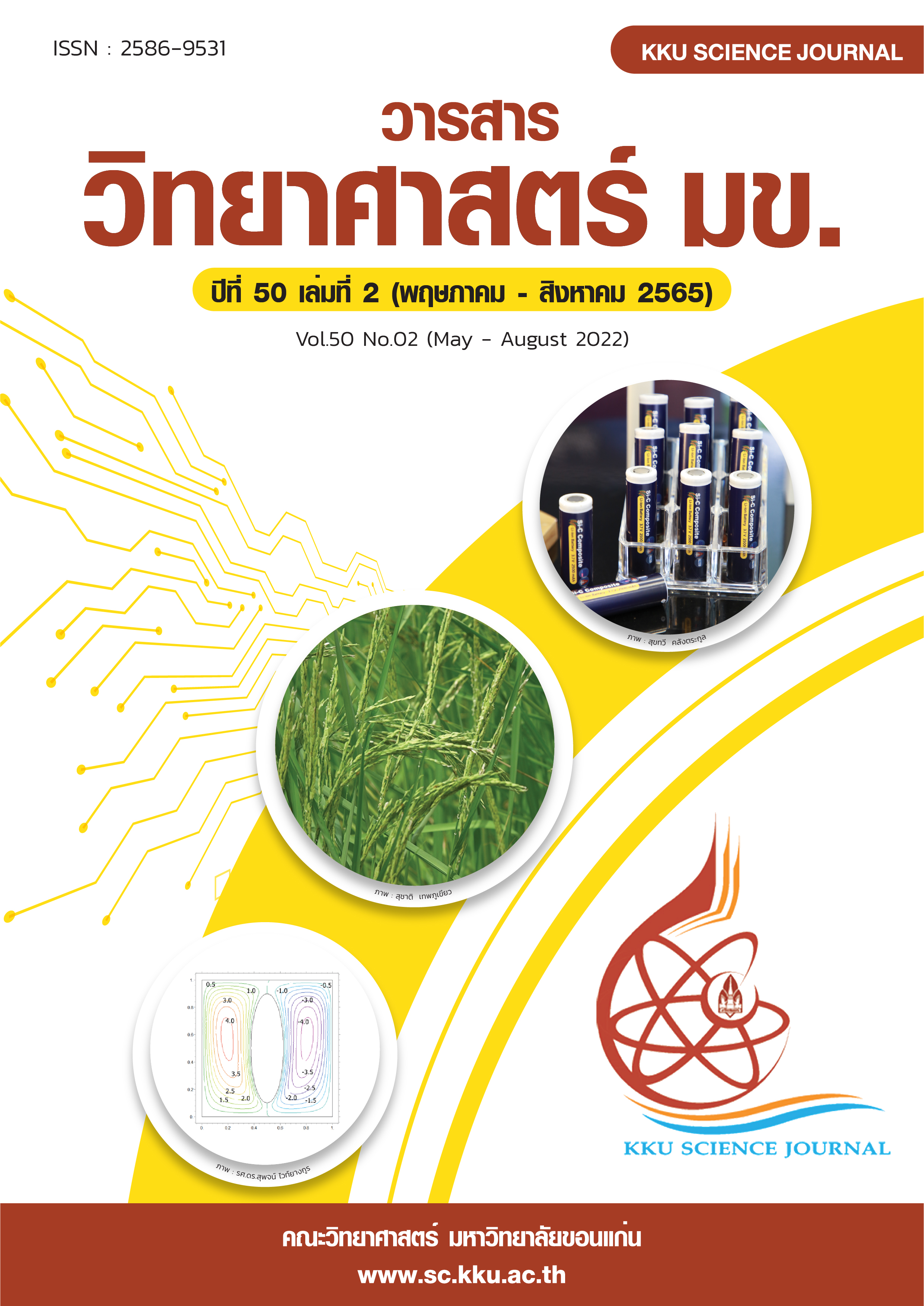The Effect of Density on Growth, CaCO3 Accumulation, Recruitment, and Mortality Rates of Halimeda macroloba Decaisne
Main Article Content
Abstract
Halimeda macroloba Decaisne is a macrophytic green alga (Chlorophyta, Ulvophyceae) widely distributed in the tropical and sub-tropical marine ecosystems. It plays important role not only primary producers, but also potential calcium carbonate producer in the coastal ecosystems. The loss of this calcified Halimeda might have negative effects on ecosystem, decreasing the CaCO3 sands. Little is known of the effects of density on the population dynamics and CaCO3 contribution. Thus, the objective of the present study was to investigate the effects of population density on growth, CaCO3 accumulation, recruitment, and mortality rates. Three different density treatments were selected in a natural population of H. macroloba. A natural density of 19 thalli quadrat-1 was used as the medium-density treatment, and the low- and high-density treatments had respectively 10 thalli quadrat-1 and 38 thalli quadrat-1. Each individual was tagged and monitored for two months (December 2019 to January 2020) in order to determine the recruitment and mortality rates. Alizarin Red-S marking was used to indicate the growth and CaCO3 accumulation of H. macroloba. Our results revealed that no significant difference in recruitment and mortality rates were observed among the three treatments. However, the growth and CaCO3 accumulation rates in the low-density treatment appeared to be higher than those of high-density treatments. The area of the low-density treatment showed the highest growth rate and CaCO3 accumulation rate with 37.27±3.21 mg thallus-1 day-1 and 36.72±0.7 mg CaCO3 thallus-1 day-1, respectively. In conclusion, this work provides basic knowledge of population density of macrophytic green alga H. macroloba in relation to its growth and CaCO3 accumulation. Further investigation on other ecological and physiological parameters would help understanding the effect of density on growth and CaCO3 production in marine ecosystem of Lidee Island, Satun Province.
Article Details

This work is licensed under a Creative Commons Attribution-NonCommercial-NoDerivatives 4.0 International License.
References
Ang, Jr. P.O. and De Wreede, R.E. (1992). Density-dependence in a population of Fucus distichus. Marine Ecology Progress Series 90(2): 169–181.
Arenas, F., Viejo, R.M. and Fernández, C. (2002). Density-dependent regulation in an invasive seaweed: responses at plant and modular levels. Journal of Ecology 90(5): 820–829.
Borlestean, A., Frost, P.C. and Murray, D.L. (2015). A mechanistic analysis of density dependence in algal population dynamics. Frontiers in Ecology and Evolution 3:37.
Conitz, J.M., Fagen, R. and Stekoll, M.S. (2013). Effects of density and substrate type on recruitment and growth of Pyropia torta (Rhodophyta) gametophytes. Botanica Marina 56(5-6): 525–533.
Dean, T.A. and Jacobsen, F.R. (1984). Growth of juvenile Macrocystis pyrifera (Laminariales) in relation to environ mental factors. Marine Biology 83: 301–311.
Dean, T.A., Thies, K. and Lagos, S.L. (1989). Survival of juvenile giant kelp: the effects of demographic factors, competitors, and grazers. Ecology 70(2): 483–495.
Flores-Moya, A., Fernández, J.A. and Niell, F.X. (1996). Growth pattern, reproduction, and self-thinning in seaweed.Journal of Phycology 32(5): 767–769.
Hoegh-Guldberg, O., Mumby, P.J., Hooten, A.J., Steneck, R.S., Greenfield, P., Gomez, E. and Hatziolos, M.E. (2007). Coral reefs under rapid climate change and ocean acidification. Science 318(5857): 1737–1742.
Hruby, T. and Norton, T.A. (1979). Algal colonization on rocky shores in the Firth of Clyde. Journal of Ecology 67(1): 65–77.
Lazo, M. L. and Chapman, A.R.O. (1998). Components of crowding in a modular seaweed: sorting through the contradictions. Marine Ecology Progress Series 174: 257–267.
Mayakun, J. and Prathep, A. (2019). Calcium carbonate productivity by Halimeda macroloba in the tropical intertidal ecosystem: The significant contributor to global carbonate budgets. Phycological Research 67(2): 94–101.
Mayakun, J., Liao, C.P. and Liu, S.L. (2020). The standing stock and CaCO3 contribution of Halimeda macroloba in the tropical seagrass-dominated ecosystem in Dongsha Island, the main island of Dongsha Atoll, South China Sea. Journal of the Marine Biological Association of the United Kingdom 100(8): 1219–1227.
Perry, C.T., Morgan, K.M. and Salter, M.A. (2016). Sediment generation by Halimeda on atoll interior coral reefs of the southern Maldives: A census-based approach for estimating carbonate production by calcareous green algae. Sedimentary Geology 346: 17–24.
Prathep, A., Kaewsrikhaw, R., Mayakun, J. and Darakrai, A. (2018). The effects of light intensity and temperature on the calcification rate of Halimeda macroloba.Journal of Applied Phycology 30: 3405–3412.
Reed, D.C. (1990). An experimental evaluation of density dependence in a subtidal algal population. Ecology 71(6): 2286-2296.
Vadas, R.L., Wright, W.A. and Miller, S.L. (1990). Recruitment of Ascophyllum nodosum: wave action as a source of mortality. Marine Ecology Progress Series 61(3): 263–272.
Vadas, R.L. Sr., Johnson, S. and Norton, T.A. (1992). Recruitment and mortality of early post-settlement stages of benthic algae. British Journal of Phycology 27(3): 331–351.
Van Tussenbroek, B.I. and Van Dijk, J.K. (2007). Spatial and Temporal variability in biomass and production of psammophytic Halimeda incrassata (Bryopsidales, Chlorophyta) in a Caribbean reef lagoon. Journal of Phycology 43(1): 69–77.
Viejo, R.M. and Åberg, P. (2001). Effects of density on the vital rates of a modular seaweed.Marine Ecology Progress Series 221: 105–115.
Walters, L.J., Smith, C.M., Coyer, J.A., Hunter, C.L., Beach, K.S. and Vroom., P.S. (2002). Asexual propagation in the coral reef macroalga Halimeda (Chlorophyta, Bryopsidales): production, dispersal and attachment of small fragments. Journal of Experimental Marine Biology and Ecology 278(1): 47–65


